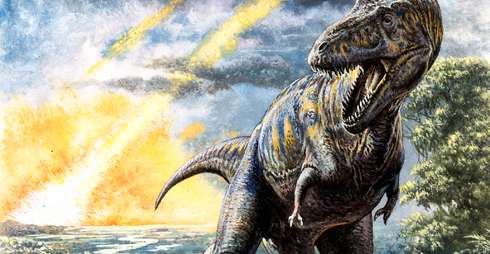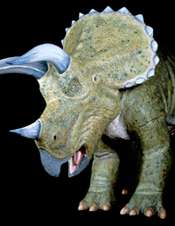Dinosaurs doing well before asteroid impact

A new analysis of fossils from the last years of the dinosaurs concludes that extra-terrestrial impact was likely the sole cause of extinction in most cases.
Although some groups of dinosaurs were declining in certain populations, dinosaurs in general were doing well before the impact of a 10km-wide asteroid or comet.
The impact caused huge tsunamis, earthquakes and wildfires. Everything over 25kg went extinct, paving the way for small birds and mammals to flourish in the aftermath.
Other pressures
The impact is well-established as the final cause of the demise of the dinosaurs. However, several other major changes were occurring on Earth at the time, leading to the suggestion that dinosaurs were already declining, and that the impact was the final straw.
Dinosaurs went extinct at the end of the Cretaceous period, 66 million years ago. Over the last few million years of the Cretaceous, environmental changes included huge temperature variations, sea-level swings and massive outpourings of volcanism in India.
Using the most up-to-date records of dinosaur fossil assemblages occurring in the last 18 million years of the Cretaceous, a team of researchers from some of the top institutions and dinosaur museums around the world, including Dr Paul Barrett from the Natural History Museum, conclude that in most cases the impact was the 'smoking gun for the cause of the extinction.'

Little decline
In some regions, there was evidence of certain groups of large herbivores declining in species diversity, which could make the communities that depend on them for food more vulnerable to extinction from external pressures such as an impact.
Overall, though, dinosaur species diversity appeared to be relatively stable despite the large-scale changes occurring over the last few million years.
New fields of study
However, the work is based largely on sites in North America, where the most complete and continuous dinosaur fossil records from the end of the Cretaceous have been described.
'It is unusual for so many experts from a consortium of world-leading intuitions to reach consensus over a big question like this,' said Dr Barrett.
'Having this agreed view helps to set an agenda to guide palaeontologists interested in finding more evidence regarding the speed and structure of the extinction.' This agenda includes looking at regions with the potential for the same detailed records as in North America, including sites in Spain and China.
Zooming in on the cause
The timing of the impact also coincides with a pulse in volcanic activity from India. The dinosaur fossil record is not yet complete enough to say what effect the increase in dust, sulphur and carbon dioxide in the atmosphere from the volcanism would have had on dinosaur communities immediately prior to the impact.
With focused research on this time period across the globe, Dr Barrett is hopeful we can gain an even clearer understanding of the timing and tempo of the dinosaur extinction.
'This will give us a much clearer picture of our past and perhaps even an understanding of the environmental and ecological factors that could cause or accelerate extinctions in the future.'
Provided by Natural History Museum




















